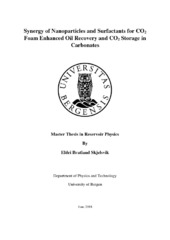| dc.contributor.author | Skjelsvik, Eldri Bratland | |
| dc.date.accessioned | 2018-08-27T15:12:31Z | |
| dc.date.available | 2018-08-27T15:12:31Z | |
| dc.date.issued | 2018-06-20 | |
| dc.date.submitted | 2018-06-19T22:00:17Z | |
| dc.identifier.uri | https://hdl.handle.net/1956/18260 | |
| dc.description.abstract | This experimental thesis is a part of an ongoing CO2-foam project lead by the Reservoir Physics group at the Department of Physics and Technology, University of Bergen. The main thesis objective was to investigate the separate and combined use of silica nanoparticles and surfactants as foaming agents for CO2-foam. A comprehensive study has been conducted at various experimental conditions to evaluate nanoparticle stability, foamability with different foaming agents, and the performance of CO2-foam stabilized by nanoparticles for enhanced oil recovery (EOR). Static stability tests of separate and combined use of hydrophilic silica nanoparticles and nonionic or cationic surfactants were conducted to qualitatively study interactions between the foaming agents at elevated temperatures. The effect of oil on nanoparticle- and/or surfactant-stabilized foam was quantitatively determined for bulk-generated foam and foam generated in porous media. Tertiary CO2-foam for EOR injections compare the performance of nanoparticles (separate or in synergy with surfactants) as CO2 foaming agents for foam stabilization and enhanced oil recovery. Foam was generated in-situ in Edwards limestone and Bentheimer sandstone cores with supercritical CO2 at miscible conditions between CO2 and oil during CO2-foam EOR injections. Carbon storage was also quantitatively determined as an element of Carbon Capture, Utilization and Storage (CCUS). In addition, nanoparticle retention studies were performed to investigate loss of nanoparticles during core injections. Bulk foam stability tests investigated the effect of oil on foam coalescence of N2-generated foam stabilized by different foaming agents at ambient conditions. The experimental results indicated that oil had a detrimental effect on bulk foam stability. Presence of oil was also studied during CO2-foam injections in porous media, where the effect of oil was detrimental on weak foams, whereas stronger foams attained a stabilizing effect from injected oil by oil-in-water emulsions. Measured nanoparticle retention was in the lower range of literature values for surfactant retention. Optimum gas fractions for CO2-foam EOR injections were determined during foam quality scans of co-injected CO2 and foaming agent. A quantitative experimental analysis of oil recovery efficiency and pressure gradients during CO2-foam EOR was used to evaluate the feasibility of using nanoparticles (separate or in synergy with surfactants) for CO2 mobility reduction. Silica nanoparticles (NPA) were co-injected with two types of surfactants during foam scans and CO2-foam EOR injections: a nonionic (SurfA) and a switchable cationic (SurfB) surfactant. At the experimental conditions used, NPA combined with SurfB showed better performance in terms of incremental oil recovery and increased differential pressure compared to the combination of NPA and SurfA. SurfB used separately or in combination with nanoparticles outperformed the separate use of NPA and SurfA as foaming agents in limestone. Carbon negative oil production (more carbon stored than produced during combustion of produced oil) was achieved during SurfA-stabilized foam in sandstone and NPA-stabilized foam (with and without SurfA) in limestone, and generation of strong foam and/or emulsions were beneficial for CO2 storage. Limestone dissolution due to the acidic effect of co-injected CO2 and brine positively affected the carbon storage capacity due to expansion of the pore volume. | en_US |
| dc.language.iso | eng | eng |
| dc.publisher | The University of Bergen | en_US |
| dc.subject | CO2 | eng |
| dc.subject | Foam | eng |
| dc.subject | CO2 Foam | eng |
| dc.subject | Nanoparticles | eng |
| dc.subject | Surfactants | eng |
| dc.subject | EOR | eng |
| dc.subject | CO2-injeksjon | nob |
| dc.subject | CO2-lagring | nob |
| dc.subject | CO2-skum | nob |
| dc.subject | Karbonatbergarter | nob |
| dc.subject | Nanopartikler | nob |
| dc.subject | Overflateaktive stoffer | nob |
| dc.subject | Økt oljeutvinning | nob |
| dc.title | Synergy of Nanoparticles and Surfactants for CO2 Foam Enhanced Oil Recovery and CO2 Storage in Carbonates | en_US |
| dc.type | Master thesis | |
| dc.date.updated | 2018-06-19T22:00:17Z | |
| dc.rights.holder | Copyright the Author. All rights reserved | en_US |
| dc.description.degree | Masteroppgave i petroleumsteknologi | en_US |
| dc.description.localcode | MAMN-PETR | |
| dc.description.localcode | PTEK399 | |
| dc.subject.realfagstermer | https://data.ub.uio.no/realfagstermer/c009825 | |
| dc.subject.realfagstermer | https://data.ub.uio.no/realfagstermer/c011927 | |
| dc.subject.realfagstermer | https://data.ub.uio.no/realfagstermer/c032045 | |
| dc.subject.realfagstermer | https://data.ub.uio.no/realfagstermer/c031431 | |
| dc.subject.realfagstermer | https://data.ub.uio.no/realfagstermer/c000860 | |
| dc.subject.realfagstermer | https://data.ub.uio.no/realfagstermer/c032046 | |
| dc.subject.realfagstermer | https://data.ub.uio.no/realfagstermer/c001045 | |
| dc.subject.nus | 752223 | eng |
| fs.subjectcode | PTEK399 | |
| fs.unitcode | 12-24-0 | |
